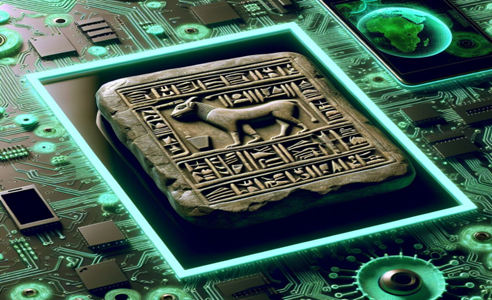The origins of information storage
We are talking about 3,000 years BC. The progress of civilisations has been accompanied by advances in information management, for which it has been necessary to record, store, process and analyse it in order to make decisions with it.
Sumerian tablets were used to keep detailed and accurate inventories of grain, livestock, tools and other resources. By comparing these inventories, they identified trends, anticipated shortages and adjusted production and trade strategies.
They also recorded trade transactions, taxes and wages. It was arguably the first accounting system.
This data, stored on clay tablets, was used to identify patterns and trends, as well as to assess risks and make decisions to mitigate them and optimise resources. This is no different from what we can do today with ICTs.
Technical and scientific progress has multiplied by several orders of magnitude the possibilities available to us for recording, storing and processing information. In the same way, this advance in ICT has in some ways allowed us to give back to our earth some of what it provided us with in the first place.

The importance of the environmental footprint
The environmental footprint is a measure to quantify the demand we make on the earth’s natural resources and the amount of waste we generate in our daily activities.
The use of ICT has the potential to have a positive impact on the environmental footprint, including the prevention of pollution and the reduction of greenhouse gas emissions.
Factors that will influence the environmental footprint are the way in which we consume products and services, the production processes, the need for the means of transport we demand and the amount of waste we generate in our activity.
Concepts such as sustainable ICTs, green computing or green IT are based on the study of good practices and the use of ICTs to minimise the environmental impact and enhance the positive effects that can be generated by using them.
For this reason, at the last UN climate summit held in November 2024, a special focus was placed on the use of digitalisation for decarbonisation and minimisation of the environmental footprint.
One of the decisions that was re-proposed by the telecommunications industry after this meeting, and which is currently pending implementation by the EU, was to include electronic communications networks as a specific sustainable activity within the EU Taxonomy. This would allow directing investments towards green digital networks, ensuring that they are aligned with the climate objectives set in Europe within the European Green Pact.
The role of business with the use of ICTs
The EU, through the Digital Economy and Society Index (DESI) report , monitors the degree of digitisation of businesses in the different EU countries in line with the Digital Decade 2023 strategic agenda. The report collects indicators to monitor progress against the digital targets. From 2021, the ICT use for environmental sustainability indicator has been included. This indicator measures the impact of ICT for more environmentally friendly actions within the company. The data is obtained through surveys, the final report of which is available from any European documentation centre.
The report’s analysis indicates that more than half of EU companies use ICTs to enable them to reduce their environmental footprint. When related to company size, the motivation of large companies is slightly higher than smaller ones.
The survey data tells us that 65% of companies have among their objectives the reduction of their environmental footprint and, as mentioned above, large companies have more ambitious objectives in this respect.
To a greater extent, the use of ICTs is used for process optimisation (77%), reduction of natural resource consumption (64%) and creation of environmental guidelines (59%), but also to a lesser extent for impact measurement (36%) and environmental impact compensation (26%).
To monitor the digitisation of companies, the DESI report relies mostly on technical indicators, so including an indicator related to sustainability and the environmental footprint of ICT use is a further point in favour of the use of digitisation in companies. It is important that companies have profiles responsible for monitoring environmental objectives and their relationship with ICTs, either because ICTs indirectly improve these objectives or because the use of ICTs is necessary to achieve these environmental objectives.
From the EU report we know that almost 30% of EU companies do not have a person responsible for monitoring environmental objectives, this percentage varies according to the size of the company, with micro or small companies being less likely to have this profile, compared to medium or large companies that usually do.
The vast majority of companies link the use of ICTs and the reduction of their environmental footprint. They mostly identify possibilities such as teleworking (83%) or reducing business travel (78%) and technologies such as collaborative platforms (78%) or cloud computing (70%).
Conclusions
In the history of recording, storing and processing information, natural resources have been both the basis and the end of its objectives. Early civilisations such as the Sumerians were already doing this. We cannot dissociate one from the other, which is why the EU has considered tracking an indicator that can relate the use of ICTs to the positive impact they can have on environmental sustainability.
There are many examples and it is necessary that, as far as possible, all company employees take into account environmental criteria in their daily work. Thinking in a general way about reducing the environmental footprint has as a consequence that we make an efficient use of resources and therefore benefit directly or indirectly.
In line with its commitment to sustainable development and the use of ICTs, Telefónica dedicated a special section in the presentation to its vision for the EU’s new institutional cycle (2024-2029) with the report: “EU 2024-2029: Forging a competitive path. Digital by innovation, green by design ‘ and the slogan for the digital and green transition: ’digital by innovation, green by design’.
Let us move forward along these lines to achieve, among all of us, improvements in business competitiveness and care for the planet.







